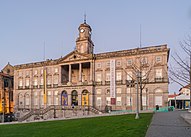Porto
Porto | |
|---|---|
Municipality | |
Top to bottom, left to right: View of Ribeira district and Luís I bridge from Vila Nova de Gaia, Casa da Música concert hall, Porto City Hall, Palácio da Bolsa, Church of Saint Ildefonso | |
| Nickname(s): A Cidade Invicta ("The Undefeated City"), A Cidade da Virgem ("The City of the Virgin") | |
| Motto(s): Antiga, Mui Nobre, Sempre Leal e Invicta (Ancient, Most Noble, Always Loyal and Undefeated) | |
| Coordinates: 41°9′43.71″N 8°37′19.03″W / 41.1621417°N 8.6219528°W | |
| Country | |
| Region | Norte |
| Subregion | Grande Porto |
| District | Porto |
| Settlement | 275 BCE |
| Municipality | 868 |
| Civil parishes | 7 |
| Government | |
| • Type | LAU |
| • Body | Câmara Municipal |
| • Mayor | Rui Moreira |
| • Municipal Assembly Chair | Miguel Pereira Leite |
| Area | |
| • Municipality | 41.42 km2 (15.99 sq mi) |
| Elevation | 104 m (341 ft) |
| Population (2021) | |
| • Municipality | 231,962[1] |
| • Urban | 1,385,454[1] |
| • Metro | 1,737,395[1] |
| Time zone | UTC0 (WET) |
| • Summer (DST) | UTC+1 (WEST) |
| Postal Zone | 4000-286 Porto |
| Area code | (+351) 22[2] |
| Demonym | Portuense, Tripeiro (informal) |
| Patron Saint | Our Lady of Vendôme |
| Municipal Holidays | 24 June (São João) |
| Website | www |
| Geographic detail from CAOP (2010)[3] produced by Instituto Geográfico Português (IGP) | |
| Official name | Historic Centre of Oporto, Luís I Bridge and Monastery of Serra do Pilar |
| Criteria | iv |
| Reference | 755 |
| Inscription | 1996 (20th Session) |
Porto or Oporto[4] (Portuguese pronunciation: [ˈpoɾtu] (![]() listen)) is the second-largest city in Portugal after Lisbon and one of the major urban areas of the Iberian Peninsula.
listen)) is the second-largest city in Portugal after Lisbon and one of the major urban areas of the Iberian Peninsula.
The urban area of Porto, which extends beyond the administrative limits of the city, has a population of 2.4 million (2011) in an area of 389 km2(150 sq mi), making it the second-largest urban area in Portugal. It is recognized as a gamma level global city by the Globalization and World Cities (GaWC) Study Group, the only Portuguese city besides Lisbon to be recognised as a global city.
Location
[change | change source]Located along the Douro river estuary in Northern Portugal, Porto is one of the oldest European centres, and its historical core was proclaimed a World Heritage Site by UNESCO in 1996. The western part of its urban area extends to the coastline of the Atlantic Ocean. Its settlement dates back many centuries, when it was an outpost of the Roman Empire. Its combined Celtic-Latin name, Portus Cale, has been referred to as the origin of the name "Portugal", based on transliteration and oral evolution from Latin. In Portuguese, the name of the city is spelled with a definite article ("o Porto"; English: the port). Consequently, its English name evolved from a misinterpretation of the oral pronunciation and referred to as Oporto in modern literature and by many speakers.
Attractions
[change | change source]One of Portugal's internationally famous exports, port wine, is named after Porto, since the metropolitan area, and in particular the cellars of Vila Nova de Gaia, were responsible for the packaging, transport and export of the fortified wine. In 2014 and 2017, Porto was elected The Best European Destination by the Best European Destinations Agency.
Gallery
[change | change source]- Porto
-
Praca da Ribeira
-
Avenida dos Aliados
-
Almeida Garret
-
Igreja dos Congregados
-
Old city
-
Sao Francisco
-
Sandeman
-
Port wine
References
[change | change source]- ↑ 1.0 1.1 1.2 "Resultados Preliminares Censos 2021 INE". Retrieved 1 September 2021.
- ↑ "Portugal International Dialing Code". Archived from the original on 30 April 2010. Retrieved 12 September 2010.
- ↑ IGP, ed. (2010), Carta Administrativa Oficial de Portugal (in Portuguese), Lisbon, Portugal: Instituto Geográfico Português, archived from the original on 3 July 2014, retrieved 1 July 2011
- ↑ "Oporto". Lexico UK Dictionary. Oxford University Press. Retrieved 8 August 2019.

















